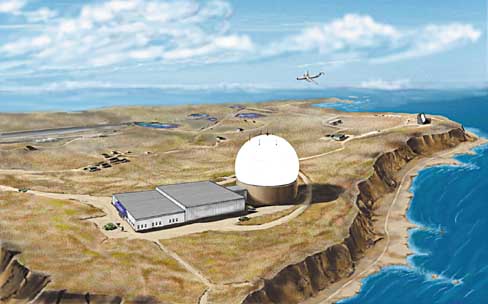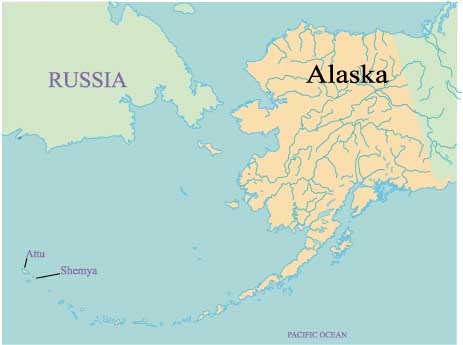Implementing a National Missile
Defense system is one of the U.S. Defense Department's top priorities.
Once the official "go-ahead" is given, DoD will be on the fast track
to deploy the system's powerful new tracking radar at one of the
toughest locales in the Air Force.
Bedding
Down the X-Band Radar:
A New Mission
Proposed for Eareckson Air Station
by Col Patrick M. Coullahan
Eleventh Air Force Civil Engineer
 A conceptual drawing of the proposed X-Band Radar at Eareckson Air Station. |
A Brief Military History of Shemya Island
Eareckson Air Station is located on Shemya Island, a diminutive piece of
real estate near the tip of the windswept Aleutian Islands in Alaska. At
1,500 air miles from Anchorage, the island is actually closer to Russia
and Japan than to Alaska's largest city. It is Shemya's location
that makes the island so important in the National Missile Defense (NMD)
strategy.
The NMD system is intended to protect all 50
states from an incoming missile. While the primary threat to the United
States no longer comes from a calculated strategic nuclear attack by the
Soviet Union, our major concerns are accidental or unauthorized missile
attacks by established powers and calculated strikes by "rogue
nations" such as Iran, Iraq and North Korea.
The need for and timing of an NMD system has
been the subject of much debate and intense scrutiny. Even so, many
people in the United States believe we have a missile defense system
already in place. Nothing could be further from the truth. In fact,
putting such a system in place will require five years of construction
and the efforts of several military and contract organizations.
A New Mission
Components of the NMD system include: ground based interceptors (GBI),
battle management command and control (BMC2), an in-flight interceptor
communications system (IFICS) data terminal, upgraded early warning
radars (UEWR) and an X-band radar (XBR).
The GBI is the weapon of the system. It is
designed to intercept incoming ballistic missile warheads outside the
earth's atmosphere and destroy them on impact. The GBIs would remain
in underground silos. Launches would occur only in defense of the United
States from a ballistic missile attack - there would be no
flight-testing of the missiles at the NMD deployment site. The GBI site
would contain launch silos and related support facilities. Up to 100 GBI
silos could be deployed. GBIs are not planned for basing at Shemya, but
could be based at Fort Greeley, near Delta Junction, Alaska, or in
northeastern North Dakota.
The BMC2 is the "brains" of the NMD system,
and the IFICS Data Terminal ground stations provide communications links
between the in-flight GBI and the BMC2.
The NMD system will require an upgrade to
existing early warning radars at Clear AS, Alaska, Beale Air Force Base,
Calif., and Cape Cod AS, Mass. These early warning radars, also referred
to as "PAVE PAWS," are phased-array surveillance radars currently
used to detect, track and provide early warning of sea-launched
ballistic missiles. They also track satellites and space debris.
Hardware and software modifications are planned for these existing
radars, in conjunction with the NMD system, to allow the acquisition,
tracking and classification of small objects near the horizon and
provide data to other NMD elements using improved communications.
The NMD system's XBR will be a ground-based,
multi-function radar capable of performing tracking, discrimination and
kill assessments of incoming ballistic missile warheads. The XBR site at
Eareckson will include a radar and associated support facilities.
Any deployment may require elements of the
system to use existing fiber optic lines, power lines and other
utilities, so modifications may be required. Some locations may require
the acquisition of new rights-of-way and installation of new utility and
fiber optic cable. Potential new land fiber optic cable line locations
include those along the Aleutian Islands to Eareckson. In addition,
redundant fiber optic cable lines may be required in some locations for
security purposes.
The 611th Air Support Group is deeply involved
in preplanning activities for this new and important mission, which will
require several million dollars in military construction (MILCON)
facilities at Shemya Island alone.
| The National Missile Defense construction and beddown at Eareckson has generated much high-level interest, leading to briefings to the Vice Chairman of the Joint Chiefs of Staff and Deputy Secretary of State. The Chairman, Senate Appropriations Committee; the Deputy Secretary of Defense; and the NASA Administrator on National Missile Defense have visited Eareckson and been briefed by the 611th Air Support Group. National news media interest in the island and the unique support role it may have in this program has increased as well. |
Challenges
Ahead
The
island of Shemya may be a perfect location for the antiballistic missile
radar, but it is a terrible place to try to build anything. But once the
President says "go," the Pentagon plans to build the new 10
story-high radar there. The plan is to have the whole system up and
running in less than five years, which, on this remote island,
translates to a war against the elements and a logistical nightmare.
The weather on Shemya poses quite a challenge
as it is very unpredictable - changing by the hour, and sometimes by
the minute. Although average precipitation is only 2 to 4 inches per
month, some form of precipitation occurs on a nearly daily basis.
The average low temperature during Shemya's
coldest month (February) is a relatively mild 28 degrees Fahrenheit, but
it is not unusual to witness hurricane force winds, enormous waves from
the meeting of the Bering Sea and Pacific Ocean, and blizzards
throughout the long winter months.
With construction on Shemya, we face monumental
logistics issues such as barge sailings and unloading in rough seas.
Equipment and supplies for the project, nearly all of the construction
materials and heavy equipment, are not found on the island and will have
to be hauled from Seattle - 3,000 miles away. This means hiring
enormous barges to make the trip, then lining them up at Shemya's one
dock to unload.
Erecting a 108-foot-high inflatable radar dome
in an area with almost no respite from high winds poses a tremendous
engineering challenge. In addition, Shemya has been rocked repeatedly by
earthquakes over the years, requiring significant seismic design efforts
to overcome the forces of Mother Nature and to prevent or keep damage to
a minimum.
A 1965 earthquake in the nearby Rat Islands
measuring 8.7 on the Richter scale caused cracks in Shemya's asphalt
runway and created crevasses with as much as 16.5 meters of vertical
displacement. Landslides occurred, water tanks twisted and underground
water pipes broke. Many aftershocks were felt during the following
weeks, and the quake generated a tsunami on Shemya reported to be about
10.7 meters high.
To counteract the effects of another earthquake
of that magnitude there, the foundation planned for the radar alone will
be over 25 feet thick and require more than 9,000 cubic yards of
reinforced concrete to construct.
Reliable and cost effective primary power is
another challenge in a place as remote as Shemya. To ensure continued
mission success, a dedicated diesel generator power plant with high
energy magnetic pulse (HEMP) shielding will be constructed to provide
mission-critical power to the NMD system.
While construction of the NMD facilities on
Shemya is very feasible, the effort will not be successful without a
great degree of coordination and preparation. The many facilities now
standing at Eareckson are a testament to DoD's ability to marshal the
resources and talent needed to effectively build in the Aleutians.
If
We Build It, They Will Come
The
latest in living amenities for assigned NMD personnel will be included
in the package. Even though Shemya is sometimes referred to as the
"Black Pearl of the Pacific," one could say it is not exactly a
Pacific island paradise. Attracting and keeping quality people with the
talent and savvy needed to run a complex that provides for our first
measure of defense from rogue nations will certainly be impacted by the
quality of life found at Shemya.
General Ronald R. Fogleman, former U.S.
Air Force chief of staff, said at the Defense Forum Foundation in
Washington D.C. on Jan. 24, 1997, that Shemya was "a God-forsaken
place if you want to know the truth." However, despite that assessment
and knowing the formidable challenges we face, we believe we can go a
long way toward enhancing quality of life on Shemya with the advent of
this new and important mission.
Col Coullahan is the
Eleventh Air Force Civil Engineer and the 611th Air Support Group Deputy
Commander, Eleventh Air Force, Elmendorf AFB, Alaska. As 11 AF Civil
Engineer, Colonel Coullahan provides policy, oversight and advocacy for
Air Force installations throughout the state of Alaska for civil
engineering and develops long-range facility plans for the MILCON
program to fulfill requirements for mission beddowns, base
infrastructure, community support and family housing.
|
A Brief Military History of Shemya Island
|


 On June 3, 1942, Japanese forces attacked U.S. Army and Navy
Forces at Dutch Harbor, in Alaska's Aleutian Island chain. Four
days later, the Japanese landed on Attu and Kiska islands, on the
western end of the Aleutian chain. The Aleutian Islanders, known
as Aleuts, living on Attu were taken to an internment camp on the
island of Hokkaido, Japan. In response, the U.S. forced Aleut
villagers on other islands to evacuate to southeast Alaska. Attu
was recaptured by U.S. forces in May 1943.
On June 3, 1942, Japanese forces attacked U.S. Army and Navy
Forces at Dutch Harbor, in Alaska's Aleutian Island chain. Four
days later, the Japanese landed on Attu and Kiska islands, on the
western end of the Aleutian chain. The Aleutian Islanders, known
as Aleuts, living on Attu were taken to an internment camp on the
island of Hokkaido, Japan. In response, the U.S. forced Aleut
villagers on other islands to evacuate to southeast Alaska. Attu
was recaptured by U.S. forces in May 1943.